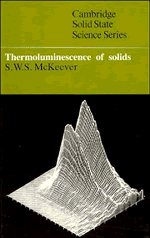Book contents
- Frontmatter
- Contents
- Preface
- 1 Introduction
- 2 Theoretical background
- 3 Thermoluminescence analysis
- 4 Additional factors governing thermoluminescence
- 5 Defects and thermoluminescence
- 6 Thermoluminescence dosimetry (TLD)
- 7 Thermoluminescence dating
- 8 Geological applications
- 9 Instrumentation
- Appendix A Minerals
- Appendix B Commercial thermoluminescence systems
- References
- Index
2 - Theoretical background
Published online by Cambridge University Press: 04 April 2011
- Frontmatter
- Contents
- Preface
- 1 Introduction
- 2 Theoretical background
- 3 Thermoluminescence analysis
- 4 Additional factors governing thermoluminescence
- 5 Defects and thermoluminescence
- 6 Thermoluminescence dosimetry (TLD)
- 7 Thermoluminescence dating
- 8 Geological applications
- 9 Instrumentation
- Appendix A Minerals
- Appendix B Commercial thermoluminescence systems
- References
- Index
Summary
Elementary concepts
The generally accepted picture of thermoluminescence outlined briefly in chapter 1 has its origins in the energy band theory of solids from which a simple explanation of the observed luminescence properties of various types of material can be obtained. It is, therefore, worthwhile to examine, in a rudimentary fashion, the energy band model of solids with a view to highlighting those characteristics which give rise to luminescence in general, and thermoluminescence in particular. Much of the modern-day theory on trapping, recombination and luminescence phenomena has remained unchanged since the original treatments provided by pioneers such as Shockley, Rose, Williams and others from the late 1940s to early 1960s. For purposes of explanation, I shall refer to several of these original works. More recent applications and confirmations of the theory will be treated in later sections and chapters of the book when specific examples are being discussed.
Energy bands and localized levels: crystalline materials
The solution of the Schrödinger equation for electrons subjected to a periodically varying potential reveals that the allowed energies for the electrons lie only in ‘allowed zones’. Other possible energy values constitute ‘forbidden zones’ or ‘band gaps’. This is the situation which arises in a solid where each atom is subject to a periodic array of potential wells, as in the Krönig-Penney model of a crystal.
- Type
- Chapter
- Information
- Thermoluminescence of Solids , pp. 20 - 63Publisher: Cambridge University PressPrint publication year: 1985
- 4
- Cited by



